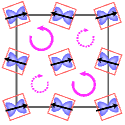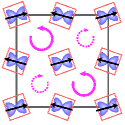Chiral contortions
Molecules that have opposite chirality are mirror images of one another, like two identical, but counter-winding staircases. Despite the subtle difference in symmetry, the two chiral forms of a molecule can have very distinct optical and catalytic properties.
The ordering of spins in a magnet can also have a definite chirality. In principle, one could imagine a host of applications if a magnetic field could switch the spins in a material between two chiralities, but such substances are rare and the effect is typically weak in those that do. Writing in Physical Review Letters, Mitsuru Saito and colleagues of Tohoku University in Sendai, Japan, report they can induce a huge change in the optical response of , —a low-temperature antiferromagnet—by rotating the spins into a chiral structure with a magnetic field.
In zero magnetic field, the spin arrangement in is a mixture of opposite chiralities. However, if a relatively small (500 G) magnetic field is applied along a certain crystallographic axis, the spins rotate into a definite chiral configuration. If the field is rotated by ninety degrees, the chirality changes.
Saito et al. confirm the magnetically switched chirality by looking for the difference in the absorption of left and right circularly polarized light for the two different field configurations. The large dichroism that they observe is four orders of magnitude larger than what has previously been reported and may put real magneto-optical applications for this material within reach. – Jessica Thomas





